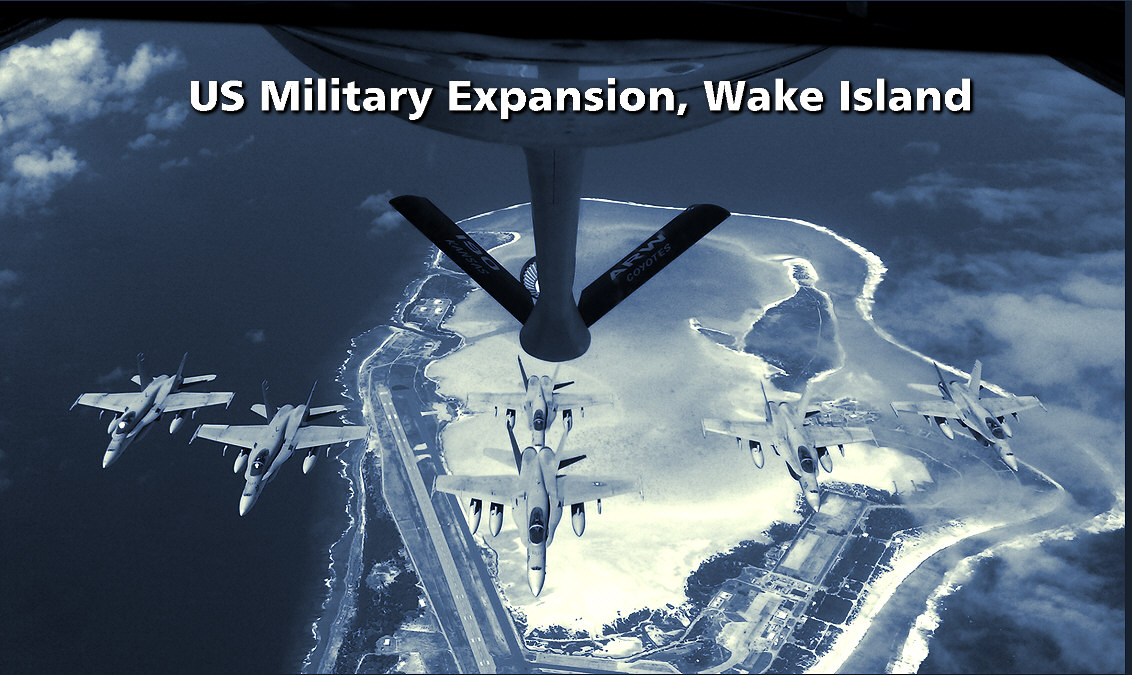
U.S. Military has carried out a considerable expansion of its airfield at Wake Island, which is situated between Japan and Hawaii and is seen as a vital staging ground for projecting power into the Western Pacific. The expansion comes amid growing tensions with China and a simmering conflict with North Korea, both of which have invested heavily in ballistic missiles and a range of other assets capable of striking Guam – currently a central hub for U.S. air and naval operations in East Asia. The U.S. has notably sought to develop facilities further afield than Guam to provide greater survivability against possible Chinese or Korea strikes to neutralize them in a war’s early stages. This previously included a major Marine facility and airfield in Australia – the latter which will be used to house American intercontinental range B-21 stealth bombers. Increased militarization of Wake Island could mark a furthering of this trend.
Wake Island a remote outpost deep in the Pacific, situated roughly between Japan and Hawaii, Wake Island serves as a reserve airfield should American airpower have to fallback from the far reaches of Western Pacific during a peer state conflict. It also provides a reverse utility, working as a staging ground in a crisis for air combat missions heading west, into Russia’s and especially China’s highly-defended anti-access and area-denial (A2/AD) bubbles that emanate far from their shores. With the ongoing ‘pivot towards the Pacific’ and with adversary A2/AD capabilities creeping farther east, Wake Island is more important than it has been in decades, possibly since World War II.
The restricted access island, which is one of the most remote on Earth—is an unincorporated territory of the United States that is also claimed by the Marshall Islands. The vast majority of the atoll is taken up by a 9,800-foot runway, long enough to accommodate anything in the Pentagon’s inventory—and the airfield infrastructure and staging areas that surround it. Although it supports some missile defense tests with launchpads scattered around its southernmost tip, it is best known for being an emergency divert point for aircraft crossing the Pacific and as a stopping point for U.S. military aircraft moving from the U.S. to Asia.
Wake Island serves as a reserve airfield should U.S. air units need to fall back from the Western Pacific, and is considerably closer to the U.S. mainland than Guam or Japan. The majority of the island is taken up by a 9,800 foot runway sufficient to accommodate anything in the Air Force’s inventory including heavy bombers. Wake Island is notably a disputed territory, and is also claimed by the Marshall Islands, although American militarisation of the territory and its value as a staging ground for offensive operations leaves little possibility that it will change hands or that the dispute could be arbitrated. The Pentagon has notably expanded its investment in military facilities on Wake Island for the past several years, reflecting its new focus on the Western Pacific region, with changes including apron and runway improvements and a installation of a large solar farm. It is expected that facilities on the territory will be hardened and fortified in the coming years to increase survivability against possible Chinese or Korean missile strikes, which are expected to occur very early in a possible conflict should the U.S. go to war in East Asia.
New satellite imagery from Planet Labs dated June 25th, 2020 shows that substantial improvements to the base have occurred recently. Based on archival satellite imagery, the major expansions to the airfield began early this year and are still underway today.
You can see a full-resolution version of here. It shows the large eastern apron area’s big expansion, as well as an enlarged secondary apron area on the west end on the runway. The runway itself has been completely rebuilt.
U.S. Military has carried out a considerable expansion of its airfield at Wake Island, which is situated between Japan and Hawaii and is seen as a vital staging ground for projecting power into the Western Pacific. The expansion comes amid growing tensions with China and a simmering conflict with North Korea, both of which have invested heavily in ballistic missiles and a range of other assets capable of striking Guam – currently a central hub for U.S. air and naval operations in East Asia. The U.S. has notably sought to develop facilities further afield than Guam to provide greater survivability against possible Chinese or Korea strikes to neutralise them in a war’s early stages. This previously included a major Marine facility and airfield in Australia – the latter which will be used to house American intercontinental range B-21 stealth bombers. Increased militarisation of Wake Island could mark a furthering of this trend.
Wake Island serves as a reserve airfield should U.S. air units need to fall back from the Western Pacific, and is considerably closer to the U.S. mainland than Guam or Japan. The majority of the island is taken up by a 9,800 foot runway sufficient to accommodate anything in the Air Force’s inventory including heavy bombers. Wake Island is notably a disputed territory, and is also claimed by the Marshall Islands, although American militarization of the territory and its value as a staging ground for offensive operations leaves little possibility that it will change hands or that the dispute could be arbitrated. The Pentagon has notably expanded its investment in military facilities on Wake Island for the past several years, reflecting its new focus on the Western Pacific region, with changes including apron and runway improvements and a installation of a large solar farm. It is expected that facilities on the territory will be hardened and fortified in the coming years to increase survivability against possible Chinese or Korean missile strikes, which are expected to occur very early in a possible conflict should the U.S. go to war in East Asia.




